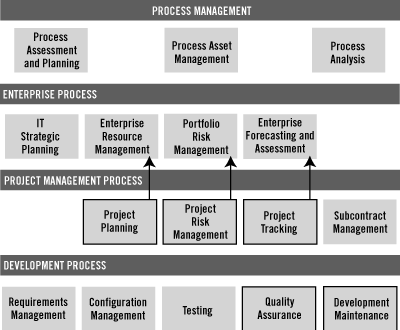
Home About me Technical Links Project Life Cycle Other Links Glossary Contact-information
A process improvement effort that suits development needs can improve organization’s overall performance in the marketplace.

• Process assessment and planning involves conducting audits of an organization’s current process maturity and developing a plan for improving the process maturity over time.
• Process asset management manages the various assets that comprise your process definition, typically including tools, checklists, policies, procedures, and so on. This key process area involves storing and maintaining the process assets so they’re easily accessible
Internal technical web site with above information current projects with
their status, people, management, tools and documents should be useful for easy
flow of the process .
• Process analysis is the ongoing task of collecting process-related metrics, using statistical analysis techniques to analyze those metrics, and identifying statistically significant deviations so you can fix the problem or ensure improvement by modifying the process.
Enterprise process management goes across project boundaries and deals with summary data at the organizational boundary level
Organizational boundaries might include the entire organization, a division, a site, or a cost center.
Key process areas include
information technology strategic planning, enterprise resource management (ERP),
portfolio risk management and enterprise forecasting and assessment.
Project management-oriented process management involves managing individual projects. Key process areas include project planning (includes Project Line Management), risk management, project tracking and subcontract management.
• Project planning is the process of developing a project baseline. It includes estimating, scheduling, decomposition into a work breakdown structure, defining dependencies, resource and labor planning, and defining deliverables.
The professional engineering training (to the
managers/new hires/employees) is also to be part of the project planning
process.
Project Line Practice/management can exploit the commonalties across software systems to reduce costs and increase quality in software products lines. (SEI-CMM PLP initiative)
• Project risk management is risk-related analysis, optimization, planning and tracking.
• Project tracking requires monitoring of the project’s actual progress relative to a plan, updating the plan as required and reporting.
• Subcontract management is procuring subcontractors’ services and
managing their efforts.
The key process areas that revolve around the software development process are (according to SEI-CMM) requirements management, configuration management, testing, quality assurance, and deployment and maintenance. For most organizations, these are the five areas that provide the highest return on investment for process improvement efforts.
• Requirements management is defining requirements and tracking them through the development life cycle.
(Definition: (according to Rational Rose ) A systematic approach to eliciting, organizing, and documenting the requirements of the system.
A process that establishes and maintains agreements between the customer and the project team on the changing requirements of the system.)
Good product definitions will eliminate/reduce the development time.
The requirements document should be continuously updated with the changes in the project requirements. Project Line Mangers/ managers, developers and testers should use this document for success of the project.
This also includes understanding of the customer requirements, usage and their business process.
• Configuration management: controls versions of software and deliverable documentation.
(Definition: The management of software development projects with respect to issues such as multiple developers working on the same code at the same time, targeting multiple platforms, supporting multiple versions, and controlling the status of code. For example beta test versus real release)
Five Objectives of the development:
·
Do more with less resources
·
Develop applications faster
·
Improve quality of the applications
·
Build the systems which will support customer
·
Explore new technologies for competitive analysis.
• Testing covers test planning, test conduct, and test tracking, including static and dynamic testing.
• Quality assurance includes overseeing the application of the various processes on a given project and verifying and validating deliverables.
Quality is a continuous process from the start to finish of the project life cycle.
• Deployment and maintenance includes post-completion activities such as site preparation, installation, training, conversion, and maintenance
External website with information for the customer
support is also helpful (with
suitable password protection).
This information is acquired and gathered from various resources and
also acquired over years of industry experience.
(This document describes levels (2-5) of SEI-CMM)